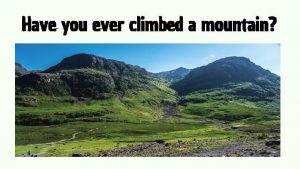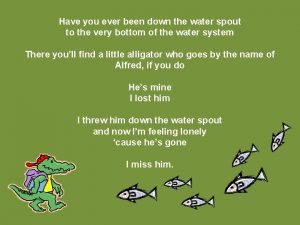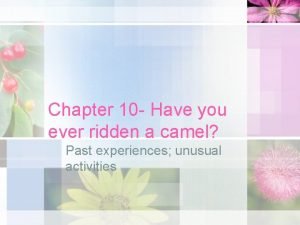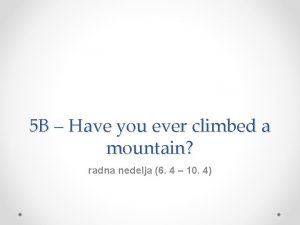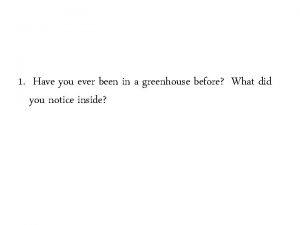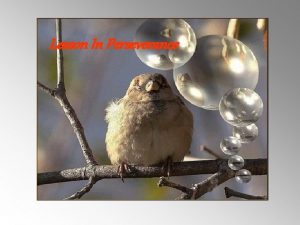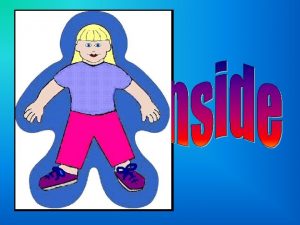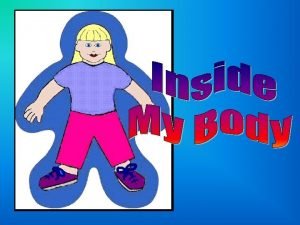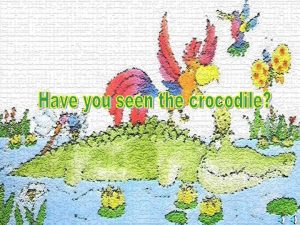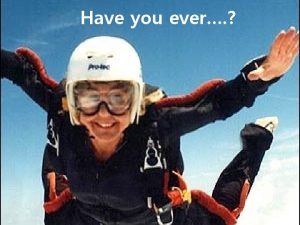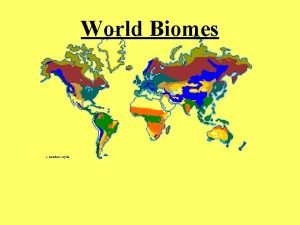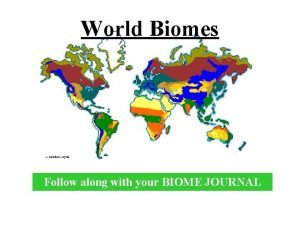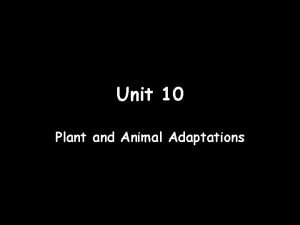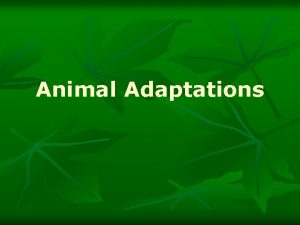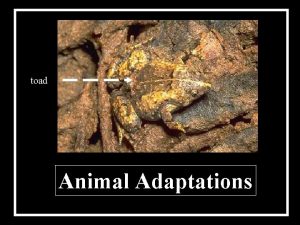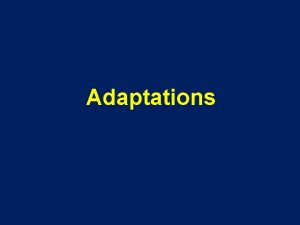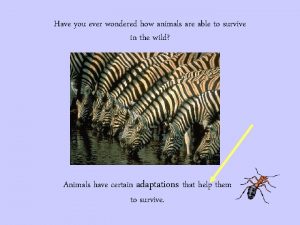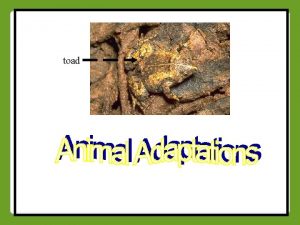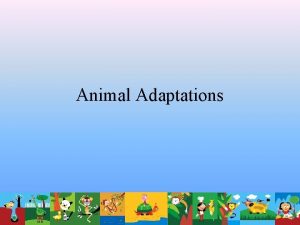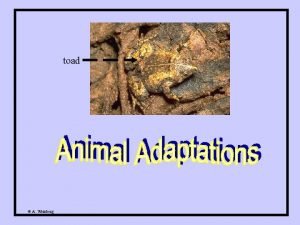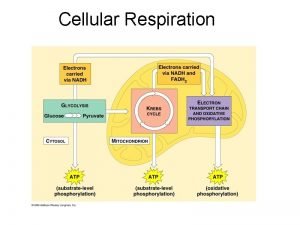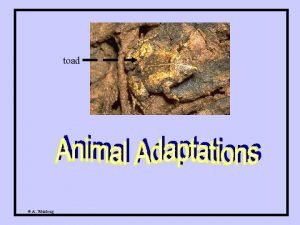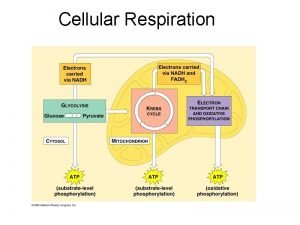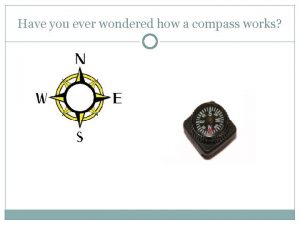Adaptations Have you ever wondered how animals are

















































- Slides: 49

Adaptations

Have you ever wondered how animals are able to survive in the wild? Animals have certain adaptations that help them to survive.

Adaptation • An organisms ability to respond to change • May be structural, behavioral, or physiology • Ex: Color Fish eyes that are larger deeper in ocean or even bioluminescent for those at the bottom Beak size to change feeding habits

Think about the way you dress in the winter. You don’t wear your shorts and bathing suit when it’s snowing outside! You wear warm clothes, and maybe even a hat and mittens to protect yourself from the weather.

And what if you are having a snowball fight? You probably run away from the person throwing at you, and maybe even try to sneak up on that person and throw some snowballs!

The way you dress in the winter, as well as the way that you run and hide from someone throwing snow at you are kinds of … Adaptations.

Physical adaptations • Hey! I’m a walking stick. I look just like a stick you’d find on the ground. © A. Weinberg Are body structures that allow an animal to find and consume food, defend itself, and to reproduce its species. • Help an animal survive in its environment

Types of Physical adaptation 1. Camouflage (use of color in a surrounding) The chameleon can change its color to match its surroundings. Can you do that?

Types of Physical adaptation 2. Mimicry(looking or sounding like another living organism) The Viceroy butterfly uses mimicry to look like the Monarch butterfly. Can you tell them apart? I’m the Viceroy! Not poisonous Poisonous I’m the Monarch!

Types of Physical adaptation 3. Chemical defenses (like venom, ink, sprays)

Types of Physical adaptations 4. Body coverings & parts (claws, beaks, feet, armor plates, skulls, teeth) The elephant’s trunk is a physical adaptation that helps it to clean itself, eat, drink, and to pick things up.

Behavioral Adaptations… Allow animals to respond to life needs. Are animals’ actions Each organism has unique methods of adapting to its environment by means of different actions.

Behavioral Adaptations Divides into two groups: Instinctive Learned These behaviors happen naturally & don’t have to be learned. These behaviors must be taught.

Types of Instinctive Behaviors

• a. This is when 1. Migration behavioural adaptation that involves an animal or group of animals moving from one region to another and then back again. • B. Animals migrate for different reasons. – – – better climate better food safe place to live safe place to raise young go back to the place they were born.

2. Hibernation • A. This is deep sleep in which animal’s body temp droops, body activities are slowed to conserve energy. • B. E. g. Bats, woodchucks & bears.

Example of Adaptation The shape of an animal’s teeth is related to its diet. – Herbivores, such as deer, have many molars(dull teeth) for chewing tough grass and plants. – Carnivores, such as lions, have sharp canines to kill and tear meat.

Click on each picture in order to read about that animal in winter. Arctic fox Bat Geese Snowshoe rabbit Caribou Brown Bear Squirrel Frog Arctic wolf Snowy owl Whale Butterfly

In winter, an Arctic fox’s fur turns white to blend in with the snow. Arctic foxes CAMOUFLAGE. Keep Going

In winter, a snowy owl’s feathers turn white to blend in with the snow. Snowy owls CAMOUFLAGE. Keep Going

In winter, geese fly south to warmer weather. Geese MIGRATE. Keep Going

In winter, whales swim south to warmer water. Whales MIGRATE. Keep Going

In winter, squirrels fall into a deep sleep until spring time. Squirrels HIBERNATE. Keep Going

In winter, some bears fall into a deep sleep until spring time. Some bears HIBERNATE. Keep Going

Click on each picture in order to read about that animal in winter. Arctic fox Brown Bear Squirrel Geese Snowy owl Whale

In winter, an Arctic fox’s fur turns white to blend in with the snow. Arctic foxes CAMOUFLAGE. Keep Going

In winter, a snowy owl’s feathers turn white to blend in with the snow. Snowy owls CAMOUFLAGE. Keep Going

In winter, geese fly south to warmer weather. Geese MIGRATE. Keep Going

In winter, whales swim south to warmer water. Whales MIGRATE. Keep Going

In winter, squirrels fall into a deep sleep until spring time. Squirrels HIBERNATE. Keep Going

In winter, some bears fall into a deep sleep until spring time. Some bears HIBERNATE. Keep Going



Thick warm, white fur coat

Thick warm, white fur coat Keeps the bear warm in below freezing temperatures and allows him to camouflage in the snow.

Thick warm, white fur coat Keeps the bear warm in below freezing temperatures and allows him to camouflage in the snow.

Thick warm, white fur coat Keeps the bear warm in below freezing temperatures and allows him to camouflage in the snow. Large Paws

Thick warm, white fur coat Keeps the bear warm in below freezing temperatures and allows him to camouflage in the snow. Large Paws Produce an oil that stops his feet freezing on the snow.

Thick warm, white fur coat Keeps the bear warm in below freezing temperatures and allows him to camouflage in the snow. Large Paws Produce an oil that stops his feet freezing on the snow.

Thick warm, white fur coat Keeps the bear warm in below freezing temperatures and allows him to camouflage in the snow. Large Paws Produce an oil that stops his feet freezing on the snow.

Thick warm, white fur coat Keeps the bear warm in below freezing temperatures and allows him to camouflage in the snow. Litt le e yes Large Paws Produce an oil that stops his feet freezing on the snow.

Litt Kee le ey and ps c es icy old bliz sno z out ard w s of t eye heir s. Thick warm, white fur coat Keeps the bear warm in below freezing temperatures and allows him to camouflage in the snow. Large Paws Produce an oil that stops his feet freezing on the snow.

Adaptation Applications: Giraffe • Why are giraffes able to go for long periods of time without water? • Answer: Giraffes drink water when available, but can go weeks without it. They rely on morning dew and the water content of their food.

Adaptation Applications: Giraffe • How are their long necks adapted to their lifestyle? • Answer: This extra length is thought to have evolved to help the giraffe spot predators and other giraffes in the distance. Interestingly, giraffes and humans have the same number of vertebrate in their necks.

Speciation Northern population Early fox population Spreads northward and southward and separates Arctic Fox Different environmental conditions lead to different selective pressures and evolution into two different species. Southern population Gray Fox Adapted to cold through heavier fur, short ears, short legs, short nose. White fur matches snow for camouflage. Adapted to heat through lightweight fur and long ears, legs, and nose, which give off more heat.

Invading the Air: Flying Reptiles • Known adaptations for sustained powered flight have appeared only three times in the evolution of terrestrial vertebrates: in pterosaurs, birds and bats. – Pterosaurs and Pterodactyls Figure 05: Pteranodon © Paul B. Moore/Shutter. Stock, Inc. Figure 04 A: Pterodactyloids Figure 04 B: Rhamphorhynchoids

Avian Dinosaurs: Birds • Based on cladistic classification, all birds nest within the dinosaur lineage Figure 06 A & B: Archaeopteryx Reproduced from Heilmann, G. The Origin of Birds. Appleton, 1927 (Reprinted Dover Publication, 1972) Figure 08: Phylogenetic relationships between birds and sauropod and ornithischian dinosaurs

The Origin of Feathers • Feathers evolved from reptilian scales for insulation and display – Three major hypotheses for their origin: • Feathers were an adaptation for insulating the (presumed) warm-blooded and grounddwelling reptilian ancestors of birds • Ancestral birds were tree-dwelling reptiles that used their developing wings to glide from branch to branch • Ancestral birds were ground-dwelling runners whose feathers formed planing surfaces increasing their speed

 Have you ever wondered
Have you ever wondered Art of questioning
Art of questioning Have you ever wondered why some people
Have you ever wondered why some people Insidan region jh
Insidan region jh For many years people have wondered
For many years people have wondered Ever ancient ever new
Ever ancient ever new Ever ancient ever new
Ever ancient ever new Have you ever looked
Have you ever looked Ever tried ever failed no matter
Ever tried ever failed no matter Have you ever done something dangerous
Have you ever done something dangerous Walmart shrinkage statistics
Walmart shrinkage statistics Have you ever read this book
Have you ever read this book Folkways
Folkways Have you ever climbed a mountain
Have you ever climbed a mountain Have you ever been down the water spout
Have you ever been down the water spout Have you ever ridden a camel?
Have you ever ridden a camel? Have you ever climbed a mountain
Have you ever climbed a mountain Have you ever seen a greenhouse
Have you ever seen a greenhouse Have you ever been to an amusement park
Have you ever been to an amusement park Have you ever watched people
Have you ever watched people Poem stanza
Poem stanza Have you ever been to disneyland
Have you ever been to disneyland Have you ever been to a zoo
Have you ever been to a zoo Have you ever seen a penguin come to tea
Have you ever seen a penguin come to tea Have you ever looked in the mirror
Have you ever looked in the mirror Have you ever looked in the mirror and thought
Have you ever looked in the mirror and thought Glass castle discussion questions by chapter
Glass castle discussion questions by chapter Have you ever thought about questions
Have you ever thought about questions Have you ever been to a museum?
Have you ever been to a museum? Have you ever met a famous person
Have you ever met a famous person Have you ever ridden a horse before in asl
Have you ever ridden a horse before in asl Plural crocodile
Plural crocodile Have you ever been scuba diving
Have you ever been scuba diving Have you ever speaking
Have you ever speaking Have you ever been sick
Have you ever been sick Match the columns have you ever told a white lie
Match the columns have you ever told a white lie Have you ever thought about inventing something
Have you ever thought about inventing something Have you ever had the feeling
Have you ever had the feeling Have you ever been to a museum
Have you ever been to a museum Have you ever questions
Have you ever questions Have you ever fly
Have you ever fly Did you ever have to finally decide
Did you ever have to finally decide Have you ever read oliver twist
Have you ever read oliver twist Have you ever shoplifted
Have you ever shoplifted Because you have rejected me i have rejected you
Because you have rejected me i have rejected you Summary of naughty boy
Summary of naughty boy Tropical rainforest animals adaptations
Tropical rainforest animals adaptations Tropical savanna animal adaptations
Tropical savanna animal adaptations Tropical rainforest animals adaptations
Tropical rainforest animals adaptations Deciduous forests around the world
Deciduous forests around the world













